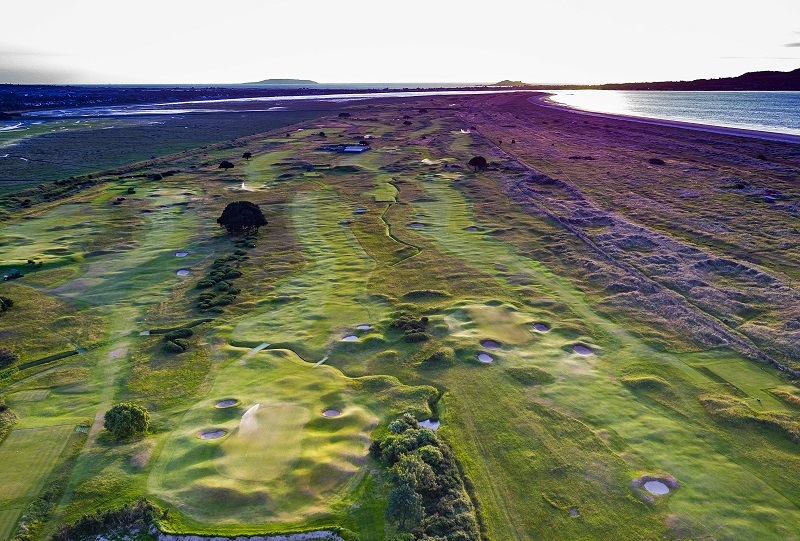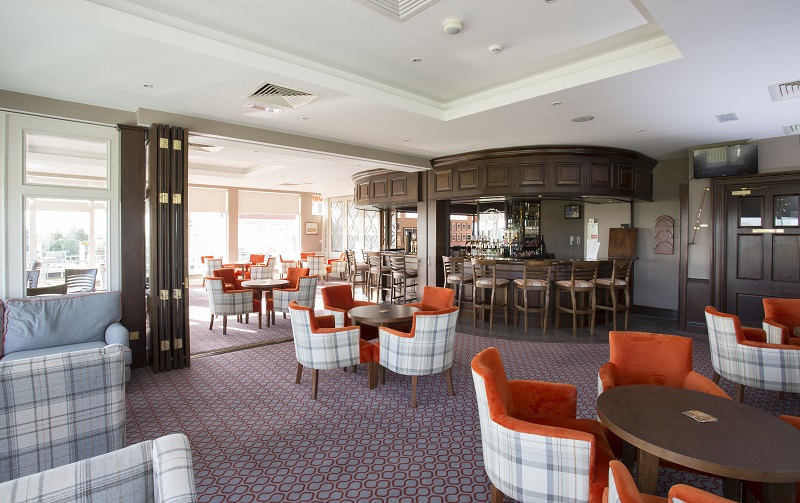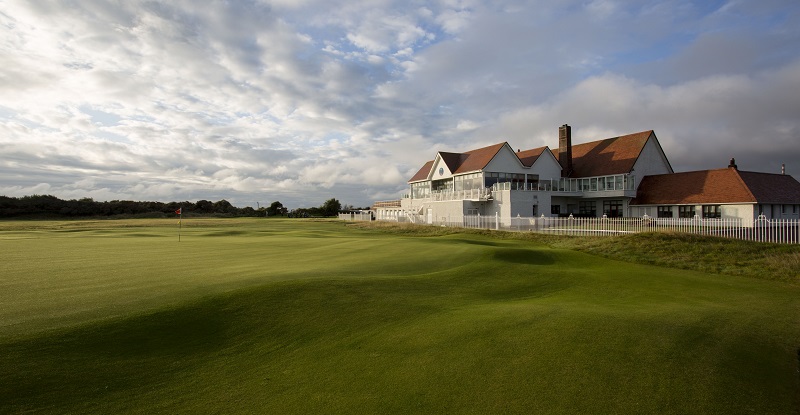Is it not an interesting quirk of history that Ireland’s newest piece of land is home to Ireland’s oldest links golf course?
It was the subject we were discussing on the balcony of Royal Dublin’s clubhouse, overlooking the par four 18th green… and yes, that’s the same hole I listed incorrectly as a par five in Destination Golf’s Top 150 Irish Courses. I have played here several times over the years so I should know better, but there is a good excuse: not only was it once a par five but it was also where Christy O’Connor Senior famously made an eagle three to win the Carrolls International in 1966. People still talk about it.
My friend and I had been playing Royal Dublin on a beautiful sunny June day when we encountered two members, Louis and Connor, on the 16th. Pace of play had slowed as we caught the four ball in front and after watching Louis drive the par four 16th (282 yards) by bouncing his way over the crisp turf and between the pincer-like bunkers, we agreed to play a two-hole match over 17 and 18, for a pint. We won 17 with a par; they won 18 with the same. Honours even… and they bought the pints.
We were enjoying those pints at one of Ireland’s few clubs to boast an island location. A history lesson on Bull Island is required for you to appreciate how this golf course came about – both in its origins and its shape. It is a fascinating story that dates back to 1800 and the unmistakeable name of Captain William ‘Mutiny on the Bounty’ Bligh. He was asked by the Director General of Inland Navigation to do a sounding of Dublin Bay. At issue were the levels of sand being carried by the tides which were obstructing large ships from entering the port. After he had completed his work, Bligh recommended that a wall (the North Bull Wall) should be constructed, parallel to the South Bull Wall, as this would prevent sand building up in the mouth of the harbour.
When the North Bull Wall was completed in 1842, sand started accumulating along its side until Bull Island emerged. The island is roughly five kilometres long and 800 metres wide and it is home to no more than two golf courses and a bird sanctuary… as well as one of Dublin’s most popular beaches (Dollymount Strand).
Forty three years later, in 1885, the Dublin Golf Club was instituted, playing first in Phoenix Park before moving to Bull Island in 1889. It gives you an idea of how quickly the island was formed. Two years after that the club received its Royal designation. Royal Dublin had found its final home on what is now the Bull Island Nature Reserve, less than 20 minutes from Dublin city centre.

In 1920, Harry Colt arrived to design a traditional links… and what he created has been receiving plaudits ever since. That sense of tradition is ably assisted by the striking red and white clubhouse that lies at the southern tip of the island. It was opened by the Taoiseach, John Costello, in 1953.
It is difficult, given such a long and rich history, to highlight just two luminaries of the club. There are those who founded it (the Scot, John Lumsden, in particular), those who designed it (Harry Colt, with revisions by Martin Hawtree in the 1990s) but the legends belong to Michael (Dyke) Moran and Christy O’Connor Senior.
Identifying these two golfing greats is made easier by plaques dedicated to them on the golf course.
The first appears on the gentle dogleg 3rd, which uses an old cottage as part of the fairway. You have to wonder how many times it has deflected balls towards the green. The plaque is on one wall. Michael "Dyke" Moran was born in this small one-roomed cottage in 1886, before the golf course existed. Twenty three years later, in 1909, he was Royal Dublin’s playing professional when he won the first of his Irish Professional Championships. He went on to win it for the next four years, a feat which has never been equalled. During those years he also tied for third place with Harry Vardon, in the 1913 Open Championship at Royal Liverpool. He died in 1918, at just 32 years of age, fighting with the Royal Irish Regiment in France.
The second legend is none other than ‘Himself’ – as the great Christy O’Connor Senior was known. He joined Royal Dublin in 1959 as the club professional. His association with the club continued for 57 years and while he won many tournaments and competed in 10 Ryder Cups, his greatest legacy must be the manner of his 1966 Carrolls International victory, here on Bull Island. On the 16th tee a plaque stops visitors in their tracks. I, for one, have read it on every visit. How many golfers can you think of who have won a tournament by finishing the last three holes eagle (2), birdie (3), eagle (3)? Is it any wonder he is so revered, not just by this club but by Ireland, too.
The clubhouse is laced with history, including rooms dedicated to Moran and O’Connor, and an essential part of any visit must include a tour of the clubhouse. The photographs, trophies, books – and the clubhouse itself –are essential for anyone who wants to get a true sense of what this club is about, as well as appreciating Irish golf’s history.

I confess to being mightily embarrassed when I realised my mistake about the 18th hole. It has not been a par five in many years and today it is a brute of a 460 yard par four. It is a right angle dogleg with out of bounds along the right, within the elbow of the dogleg. Two very good blows are required to reach the green – Himself did it with two four irons by cutting the corner – but not many of us can achieve that.
Which leads to the matter of how you play this course. There are some seriously hefty par fours here, with five over 430 yards (white tees), but the bunkers may cause the greatest fear. Their positioning is exceptional and that means every tee shot and every approach has to be evaluated with the sand in mind. What’s more, as one of Ireland’s flattest links you need to look at each hole carefully, appreciate the subtleties of the fairway shapes and then factor in the wind. Gentle doglegs abound, starting as early as the par five 2nd, and sometimes just the positioning of the tee box means club selection and line are a mass of possibilities.

Royal Dublin is famous for its classic out-and-back routing with the front nine heading north-east. These are regarded as the easier nine for the wind will typically be at your back. But then you must turn for home and that changes everything. Even Rory McIlroy found that his fine score on the front nine was hard to maintain on the homeward trail. This can best be summed up by the Index 1 10th hole, which is at the farthest reaches of the links. This is when the wind will typically be into your face. At 441 yards (white tees) it is another subtly shaped hole that drifts around two fairway bunkers on the right, before you must tackle a narrow stream immediately in front of the green. No bump and run means the adventurous golfer has to fly it the whole way, into that wind. I will add that on the day we played the wind was behind us… which made it only marginally easier: the challenge then was how to stop the ball on the green without falling victim to the endless fall-offs that sweep around most of Royal Dublin’s greens. We both failed. What the wind giveth, it taketh away!
Royal Dublin has for a long time borne the mantle of one of Ireland’s most formal clubs… but such things have been shrugged off and the club is now far more relaxed.
Visitors are welcome and welcomed and with so much to see in the clubhouse we took our time as we wandered about from room to room. (Only the Christy O’Connor Room requires guests to wear a jacket.) The Pro shop has been completely refurbished, too, and judging by our entertaining encounter with Louis and Conor, the members are an approachable bunch… and very happy to try and take a pint off you!

Your final act of the day should be to go and see Christy O’Connor Senior’s Ryder Cup in the trophy room. He should have been given ten, one for each of his appearances, but this is the only one he received and his family presented it to Royal Dublin to acknowledge the abiding relationship between Himself and this venerable club.
Visitors can play any day except Wednesday – a bonus for the weekend warrior – and green fees are €150-€175 in peak season, €95-€105 for early bird/twilight, and €80-€90 during winter.